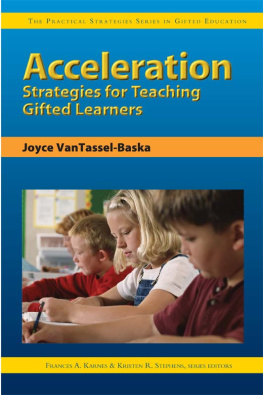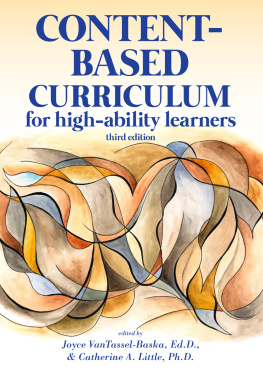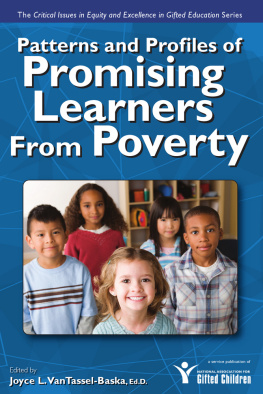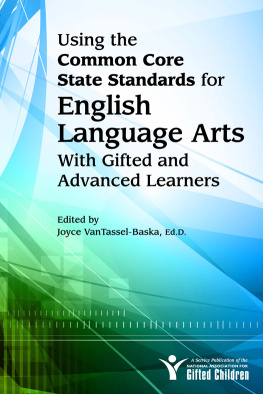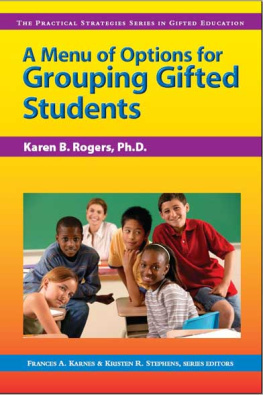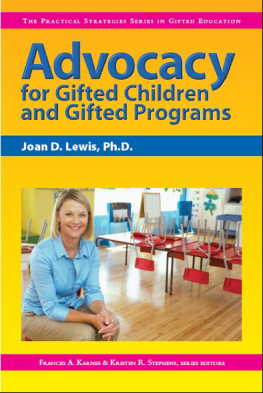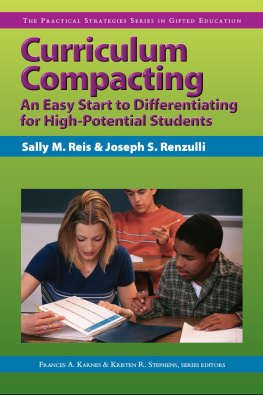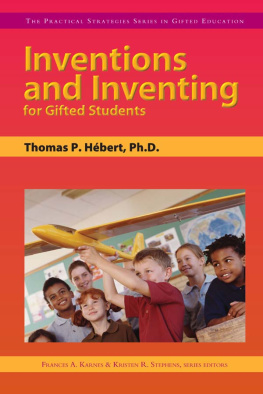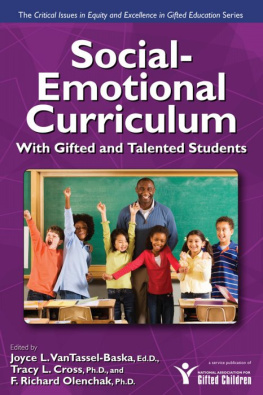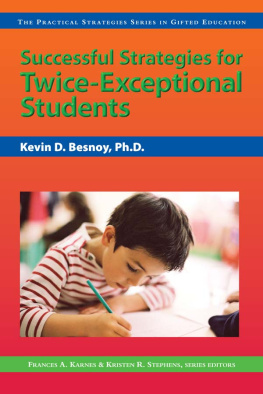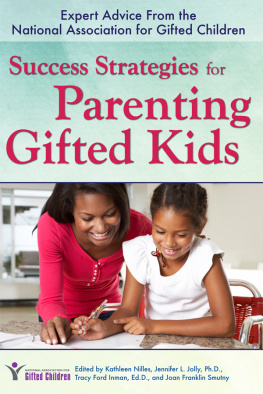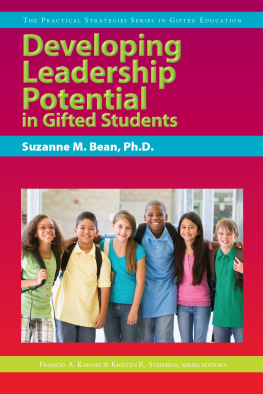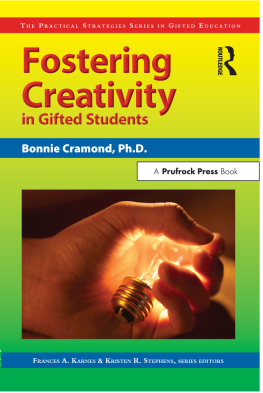THE PRACTICAL STRATEGIES SERIES
IN GIFTED EDUCATION
series editors
FRANCES A. KARNES & KRISTEN R. STEPHENS
Acceleration Strategies
for Teaching Gifted Learners
Joyce VanTassel-Baska

P RUFROCK P RESS , I NC .
Copyright 2005 by Frances A. Karnes
and Kristen R. Stephens-Kozak
All rights reserved.
No part of this book may be reproduced, translated, stored in a retrieval system, or transmitted, in any form or by any means, electronic, mechanical, photocopying, microfilming, recording, or otherwise, without written permission from the publisher.
Printed in the United States of America.
ISBN-13: 978-1-59363-777-4
At the time of this books publication, all facts and figures cited are the most current available. All telephone numbers, addresses, and Web site URLs are accurate and active. All publications, organizations, Web sites, and other resources exist as described in the book, and all have been verified. The authors and Prufrock Press, Inc., make no warranty or guarantee concerning the information and materials given out by organizations or content found at Web sites, and we are not responsible for any changes that occur after this books publication. If you find an error, please contact Prufrock Press, Inc. We strongly recommend to parents, teachers, and other adults that you monitor childrens use of the Internet.

Prufrock Press, Inc.
P.O. Box 8813
Waco, Texas 76714-8813
(800) 998-2208
Fax (800) 240-0333
http://www.prufrock.com
Contents
Series Preface
The Practical Strategies Series in Gifted Education offers teachers, counselors, administrators, parents, and other interested parties with up-to-date instructional techniques and information on a variety of issues pertinent to the field of gifted education. Each guide addresses a focused topic and is written by scholars with authority on the issue. Several guides have been published. Among the titles are:
Acceleration Strategies for Teaching Gifted Learners
Curriculum Compacting: An Easy Start to Differentiating for High-Potential Students
Enrichment Opportunities for Gifted Learners
Independent Study for Gifted Learners
Motivating Gifted Students
Questioning Strategies for Teaching the Gifted
Social & Emotional Teaching Strategies
Using Media & Technology With Gifted Learners
For a current listing of available guides within the series, please contact Prufrock Press at (800) 998-2208 or visit http:// www.prufrock.com.
Introduction
The acceleration of gifted children and their curriculum is a necessary first step in appropriate provisions for them. While many strategies are successful with the gifted, none surpass accelerations efficiency and effectiveness in promoting long-term learning in the gifted and eliminating boredom and mental laziness. As an intervention for gifted learners, however, it has been underutilized due to misconceptions and its lack of fit with school curricular organizational patterns. Yet, there are several teacher-friendly ways the process of acceleration can be employed in classrooms at all levels and in all subject areas for students requiring more advanced work.
The purpose of this publication is to share ideas and strategies for practical implementation of the process. While geared primarily to teachers, it is also useful for principals and coordinators of gifted programs to read and implement.
Review of the Research
More has probably been written about the efficacy of accelerative practices with the gifted than about any other single educational intervention with any population. Reviews of the literature on acceleration have appeared with some regularity over the last 25 years (Benbow, 1991; Daurio, 1979; Gallagher, 1969; Gross & van Vliet, 2003; Kulik & Kulik, 1984; Reynolds, Birch, & Tuseth, 1962; VanTassel-Baska, 1986). Each review has carefully noted the overall positive impact of acceleration on gifted individuals at various stages in the lifespan. Successful programs of acceleration, most notably offshoots of the basic talent search model developed by Julian Stanley and others in the 1970s, have demonstrated the significant positive impact on the learning of students from using accelerative practices (Benbow & Stanley, 1983; Gross, 2004; Kulik & Kulik, 1992b; Swiatek & Benbow, 1991a, 1991b).
Moreover, a broad-based research agenda has emerged in the field of gifted education dedicated to understanding the long-term effects of educational acceleration of the gifted (Brody, Assouline, & Stanley, 1990; Brody & Benbow, 1987; Brody & Stanley, 1991; Robinson & Janos, 1986; Swiatek & Benbow, 1991a, 1991b). These studies continue to show accelerations positive results in cognitive development and a lack of negative effects on social/emotional development. Brody and Benbow reported no harmful effects of various forms of acceleration, including grade skipping and advanced course taking, among the Study of Mathematically Precocious Youth (SMPY) students subsequent to high school graduation. Accelerated students generally earned more overall honors and attended more prestigious colleges. Richardson and Benbow (1990) and Swiatek and Benbow (1991b) subsequently reported no harmful effects of acceleration on the social and emotional development or academic achievement after college graduation. Janos, Robinson, and Lunneborg (1989) also reported no detrimental effects of acceleration on young entrants to college. In another study, Robinson and Janos found similar adjustment patterns for early entrants in comparison to three equally able nonaccelerated comparison groups, noting only unconventionality as a distinguishing characteristic of the early entrants. Another study, this one of female-only early college entrants, found positive personality growth during the accelerated first year of the program (Cornell, Callahan, & Loyd, 1991). Finally, Brody et al. (1990) found that, among accelerated students, the best predictor of college achievement was early and continued Advanced Placement course taking, suggesting that advanced, challenging work on an ongoing basis is a powerful inducement to later achievement.
Such empirical support alone would lead one to expect that the world of educational practice would wholeheartedly embrace the concept of acceleration and find diverse ways to employ it effectively in many educational settings. Regrettably, this has not been the case. Instead, there has been a deliberate shunning of this approach by the educational establishment (Jones & Southern, 1992). Some insight was gained into the dynamics of this situation when the majority of gifted program coordinators themselves were found to be philosophically against the practice (Southern & Jones, 1991). A survey of program interventions used with the at-risk gifted (VanTassel-Baska, Patton, & Prillaman, 1991) also revealed that acceleration in some form finished fifth behind such approaches as independent study, college coursework, and various enrichment strategies. This relatively low status suggests that acceleration is not a routine strategy in gifted programs despite positive research evidence supporting its effectiveness.
One tool that has emerged in the past few years to help educators assess the need for acceleration practices is the Iowa Acceleration Scale (IAS) for Whole Grade Acceleration in grades K8 (Assouline, Colangelo, Lupkowski-Shoplik, Lipscomb, & Forstadt, 2003). The IAS was modeled after the Lights Retention Scale and uses a numerical rating scale to provide structure for the acceleration decision process. The decision to accelerate a student can be controversial for both educators and parents. The scale therefore focuses on the childs intellectual and emotional development, as well as his or her maturity, attempting to address issues that could become problematic. This scale should be viewed as a tool to guide the discussion and decisions surrounding acceleration options available to gifted students. It is an attempt to take a completely subjective process and try to infuse an objective component into it. Earlier guidelines have also been delineated for considering the process of deciding on acceleration options (Feldhusen, Proctor, & Black, 1986; VanTassel-Baska, 1986).
Next page
